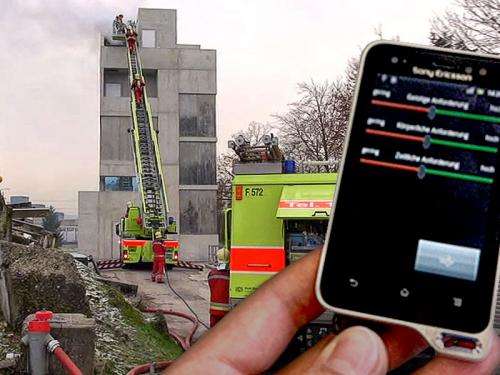App facilitates mission feedback

A doctoral student from ETH Zurich has developed a smartphone app that enables fire-fighter team processes to be recorded and evaluated. The software passed the field test with the Zurich Fire Service. Now the app is to be showcased at the international conference on ubiquitous computing Ubicomp at ETH Zurich.
A well-oiled task team is the be-all and end-all of a successful fire service. In order to save the inhabitants of a burning building from the flames, not only does the fire-fighting team need to be on site within minutes; every single member of the fire brigade also has to know exactly what needs to be done. Consequently, flawless communication within the team is crucial.
A new Smartphone app designed by a doctoral student from ETH Zurich now helps to evaluate fire-fighting operations during trainings and actual missions. If the fire-fighters activate the app at the beginning of their call-out and carry the Smartphone in their breast pockets for the duration, the app gauges the team's activity. The quantitative data gathered then helps mission control to critique manoeuvres, telling the drill instructor or brigade commander who was where, when, with whom and with whom they communicated. In other words, it enables him to reconstruct the course of a call-out in high chronological resolution.
Smartphone sensors used
The app was devised by doctoral student Sebastian Feese under the supervision of Gerhard Tröster, a professor at the Institute of Electronics, utilising the various standard sensors and transmitters built into a customary Smartphone. The researchers used the so-called ANT transmitter – technology for short-distance transmissions, much like the better known Bluetooth – to recognise which team members formed sub-groups. From the GPS and barometer data, they were able to reconstruct which fire-fighter was where and how high (on which floor of a block of flats, for instance). Using the acceleration sensor, the scientists gauged the time at which the people were moving. And thanks to the microphone and speech recognition software, they were ultimately able to discern who communicated when.
The researchers tested the app on the Zurich Nord Fire Service for six weeks – both during training exercises on the drill grounds and actual call-outs. The feedback from the fire-fighters was very positive, says Feese. For instance, incident commanders reported that they had been able to gain a vivid and detailed picture of how the operation went afterwards thanks to this data. "It is easier to obtain this kind of data with a Smartphone than with another device as it means the people are using a piece of equipment that they do day in, day out anyway. They can slip it into their breast pocket and forget all about it. It doesn't hinder them during operations," says the ETH-Zurich doctoral student.
When fire-fighters communicate pivotal
Using the data obtained, the scientists were able to illustrate that the impact of communication within the team on the team's performance depends on the situation. Teams that spoke more to each other during the execution phase tended to be slower while teams that communicated a lot during the preparatory phase of the call-out were usually faster.
"The measurements correspond to established process models from team research," says Michael Burtscher from the Department of Psychology at the University of Zurich, who was also involved in the project. If there is a lot of communication in the preparatory phase, it is mostly conducive to the team's performance. If, however, there was a lot of talk during the execution phases, this could be an indication that problems suddenly cropped up. That said, Feese also stresses that an insufficient number of measurements have been conducted thus far to make any general assumptions about team processes. The project was primarily about illustrating how the Smartphone can be used to record team work and demonstrate the app's practical feasibility.
Further developments possible
The scientists would now like to refine the app. One possibility, for instance, would be to obtain additional information from the background noise recorded, says Feese, which varies depending on the location. This should make it possible to trace a change in location with the app. It would also be conceivable for the app to record the breathing rate in future. "This should especially be possible using the Smartphone microphone if the fire-fighters are wearing breathing apparatus and their breaths are clearly audible," he says.
The researchers will be showcasing the app and results of the field test at the two conferences Ubicomp and ISWC (International Symposium on Wearable Computers) in the next few days, both of which are to take place simultaneously at ETH Zurich.
More information: "Computerisation of everyday life highly advanced": ETH Life interview with Professor Friedemann Mattern to coincide with Ubicomp 2013
Provided by ETH Zurich




















